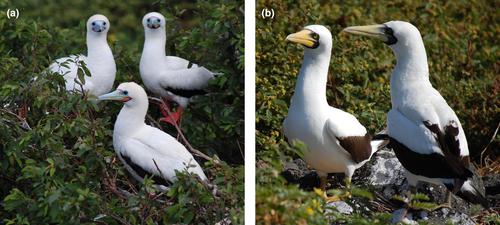当前位置:
X-MOL 学术
›
Ecol. Evol.
›
论文详情
Our official English website, www.x-mol.net, welcomes your feedback! (Note: you will need to create a separate account there.)
Variations in inter‐specific and sex‐related niche partitioning in pelagic boobies during their annual cycle
Ecology and Evolution ( IF 2.6 ) Pub Date : 2024-04-16 , DOI: 10.1002/ece3.11255 Miriam Lerma 1 , Nina Dehnhard 2 , José Alfredo Castillo‐Guerrero 3 , Salvador Hernández‐Vázquez 3 , Christian C. Voigt 4 , Stefan Garthe 1
Ecology and Evolution ( IF 2.6 ) Pub Date : 2024-04-16 , DOI: 10.1002/ece3.11255 Miriam Lerma 1 , Nina Dehnhard 2 , José Alfredo Castillo‐Guerrero 3 , Salvador Hernández‐Vázquez 3 , Christian C. Voigt 4 , Stefan Garthe 1
Affiliation

|
Animals that co‐occur in a region (sympatry) may share the same environment (syntopy), and niche differentiation is expected among closely related species competing for resources. The masked booby (Sula dactylatra ) and smaller congeneric red‐footed booby (Sula sula ) share breeding grounds. In addition to the inter‐specific size difference, females of both species are also larger than the respective males (reversed sexual size dimorphism). Although both boobies consume similar prey, sometimes in mixed‐species flocks, each species and sex may specialize in terms of their diet or foraging habitats. We examined inter‐ and intra‐specific differences in isotopic values (δ13 C and δ15 N) in these pelagically feeding booby species during the incubation period at Clarion Island, Mexico, to quantify the degrees of inter‐ and intra‐specific niche partitioning throughout the annual cycle. During incubation, both species preyed mainly on flyingfish and squid, but masked boobies had heavier food loads than red‐footed boobies. There was no overlap in isotopic niches between masked and red‐footed boobies during breeding (determined from whole blood), but there was slight overlap during the non‐breeding period (determined from body feathers). Female masked boobies had a higher trophic position than conspecific males during breeding; however, no such pattern was detected in red‐footed boobies. These results provide evidence of inter‐ and intra‐specific niche partitioning in these tropical seabird species, particularly during the breeding period and in the more‐dimorphic species. Our results suggest that these closely related species use different strategies to cope with the same tropical marine environment.
中文翻译:

中上层鲣鸟在年度周期中种间和性别相关的生态位划分的变化
在一个地区(同域)共存的动物可能共享相同的环境(同域),并且在密切相关的物种之间争夺资源时预计会出现生态位分化。蒙面鲣鸟(指藻 )和较小的同属红脚鲣鸟(苏拉苏拉 )共享繁殖地。除了种间体型差异外,两个物种的雌性也都大于各自的雄性(逆转性体型二态性)。尽管两种鲣鸟捕食相似的猎物,有时是混合物种的群体,但每个物种和性别可能在饮食或觅食栖息地方面有专门化。我们检查了同位素值的种间和种内差异(δ13 C 和 δ15 N)在墨西哥克拉里昂岛的孵化期间对这些中上层进食的鲣鸟物种进行研究,以量化整个年度周期中种间和种内生态位划分的程度。在孵化过程中,这两个物种主要捕食飞鱼和鱿鱼,但蒙面鲣鸟的食物负荷比红脚鲣鸟重。繁殖期间蒙面鲣鸟和红脚鲣鸟之间的同位素生态位没有重叠(根据全血确定),但在非繁殖期间(根据身体羽毛确定)有轻微重叠。雌性蒙面鲣鸟在繁殖过程中比同种雄性具有更高的营养地位;然而,在红脚鲣鸟身上却没有检测到这种模式。这些结果提供了这些热带海鸟物种间和种内生态位划分的证据,特别是在繁殖期和更多二态性物种中。我们的结果表明,这些密切相关的物种使用不同的策略来应对相同的热带海洋环境。
更新日期:2024-04-16
中文翻译:

中上层鲣鸟在年度周期中种间和性别相关的生态位划分的变化
在一个地区(同域)共存的动物可能共享相同的环境(同域),并且在密切相关的物种之间争夺资源时预计会出现生态位分化。蒙面鲣鸟(



























 京公网安备 11010802027423号
京公网安备 11010802027423号